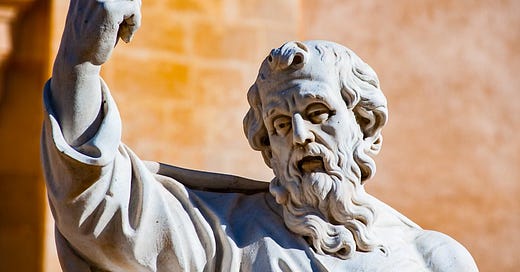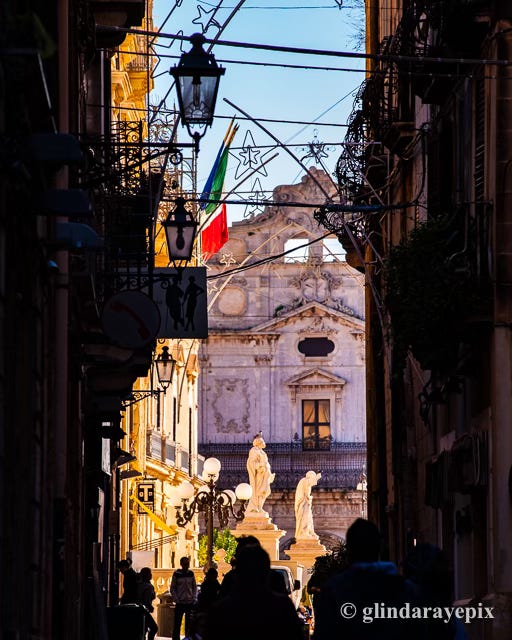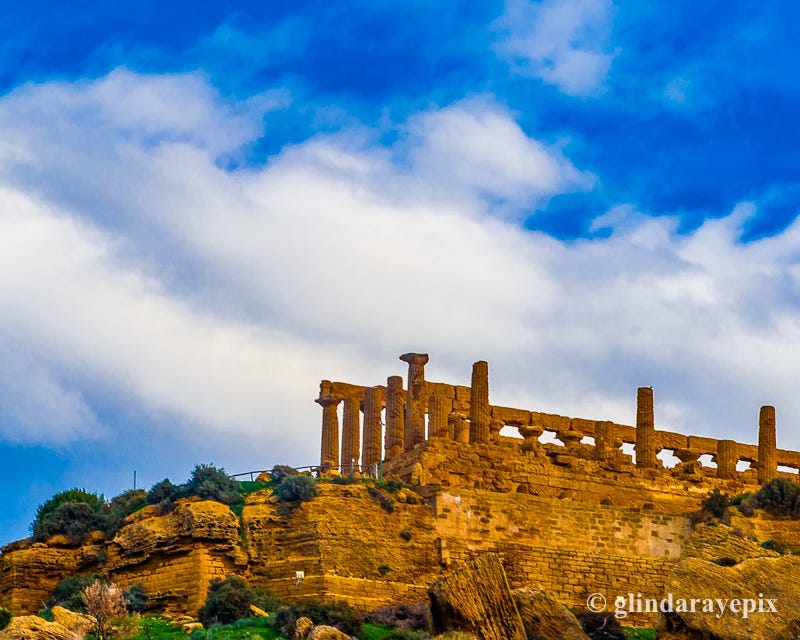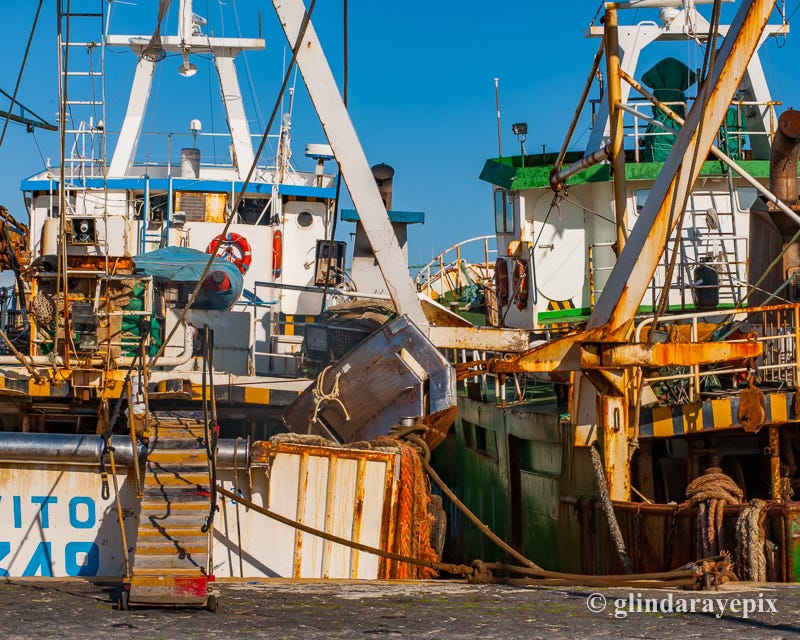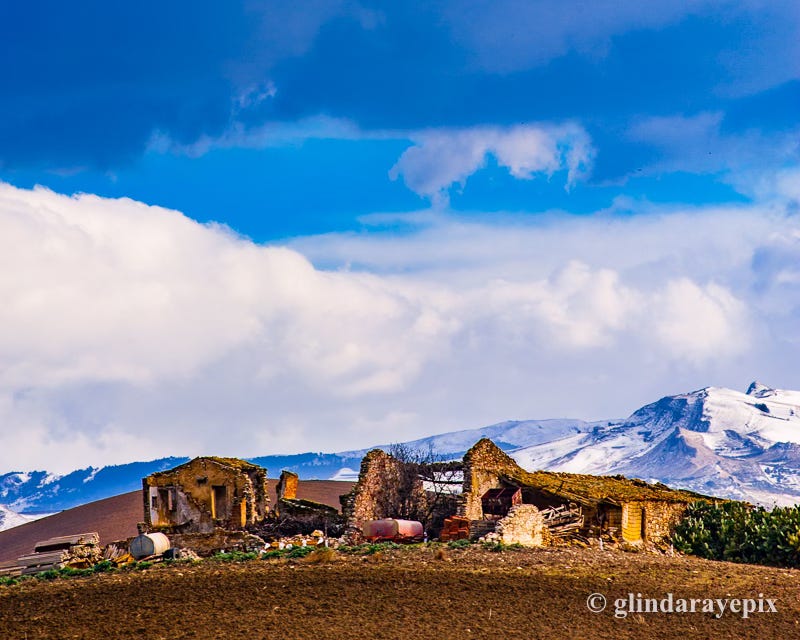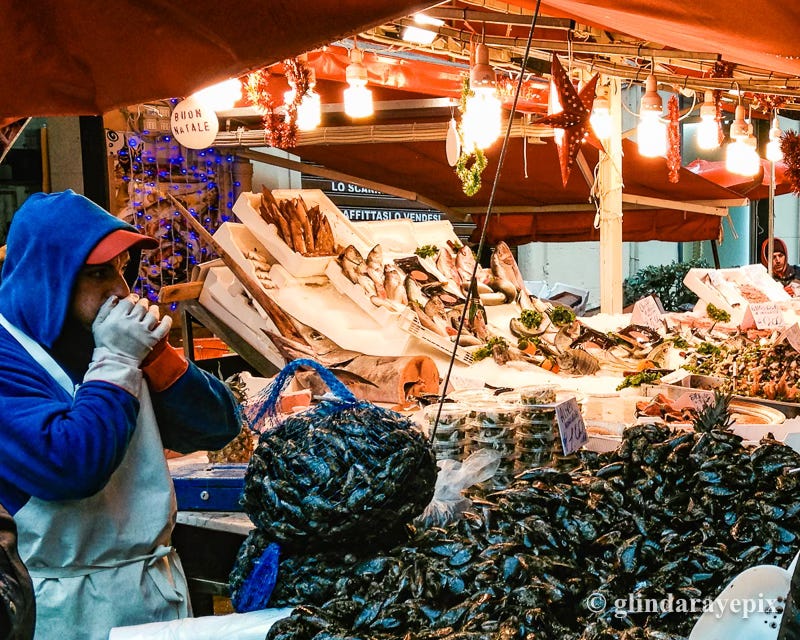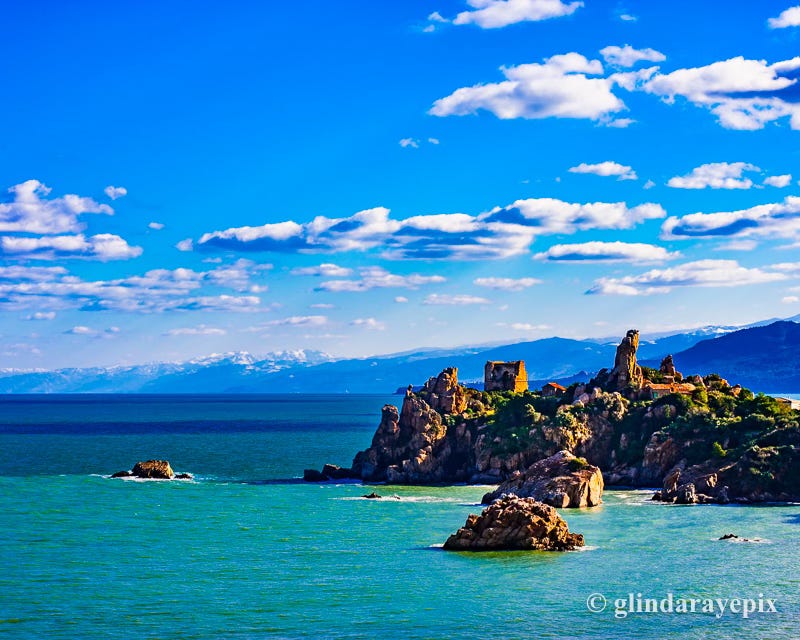On New Year’s Eve, we were waiting patiently in a backstreet Palermo pastry shop, when a pair of young men walked in. The smartly dressed lieutenant with the satchel approached the counter, while the much larger hulk in the track suit hung back by the door. Without a blink, the owner of the shop opened the register and handed over a thick manila envelope, folded and creased, with a rubber band around it. A few questions, then the lieutenant nodded, took out an account book, wrote down some figures, and replaced the book and envelope in his satchel.
None of the regulars in the shop appeared to notice our first glimpse of the informal tax paid by anyone who wants to do business in Sicily. We Americans, however, were naturally quite impressed. It’s not every day you see open extortion in action, not even in Italy.
For most of their existence, the Italian Regioni south of Naples have been a third world country, with Sicily as their even more destitute and under-appreciated orphan cousin. So when we disclosed our plan—to drive south from Rome to the Italian toe and then to board the ferry to Messina in Sicily—the rental agent took back the Volkswagen she’d just signed out to us. As she handed us the keys to a Ford, she assured us that no self-respecting Sicilian car thief would steal a Ford.
And this mattered, because our plan was to spend seven days driving the Sicilian coast in a clockwise circle, with a pair of four-day detours to the Islands of Malta and Stromboli. Neither of those two ferries would allow us to bring a car, so we’d have to leave our unloved Ford, parked and vulnerable, in a pair of sketchy port towns we’d never heard of.
The Roman government and the European Union have poured billions over the years into southern Italy in an effort to bring it into the modern age. We’ve had a front row seat at the transformation, not just of the major cities, but of the countryside from Naples south to Taranto and Catanzaro. So on this trip, our secret mission was to check out Sicily and see how much of that aid had translated into recognizable prosperity for the once benighted island.
Beyond that, we were just out for a pleasant seven-day drive, with no plans or reservations.
Giorno Uno: Messina — Monte Etna
Mount Etna is huge. It dominates the skyline from the ferry steaming out of the mainland for the 30-minute crossing of the Strait of Messina. You can circumvent il Parco dell'Etna in two and a half hours (109 miles) of rough roads and tiny villages catering to skiers and hikers. The volcano—really a volcanic field of five craters—is seriously dangerous, with regular summit and flank eruptions that toss out smoke, debris, lava bombs, and pyroclastic flows to shut down Sicilian airspace and intimidate the mountain’s neighbors in Messina and Catania.
The hiker’s depot at Il Rifugio Sapienza—literally, The Refuge of Wisdom—on the bleak southeastern flank has a cable car that takes you as close as you can get to the grumpiest southeastern craters. They also have reasonable overnight accommodations, but we don’t recommend them—when you’re done peering around for threats of volcanic action, there isn’t much else to do.
We can be a bit scatterbrained at times, and the way we found our hotel that night is illustrative. We’d assumed that they’d sell petrol on the way up to the Refuge—wrong—so by the time we reached the camp, we were completely dry. With nothing else to do, we coasted without an engine down 17km of curves, switchbacks, and straightaways into a tiny village that featured exactly one gas station—and a gorgeous villa with rooms and a superb restaurant. True serendipity.
Giorno Due: Siracusa — Ragusa — Pozzollo [Ferry to Malta]
After the barren hulk of Etna and the drab, modern cities of Messina and Catania, the drive into Siracusa was a revelation. Founded by the Corinthian Greeks as a minor outpost, it quickly grew into a Mediterranean power in its own right, its wealth coveted by Romans, Carthaginians, Arabs, Normans, and Spaniards. It was the sunniest and most eclectic, but also the most openly religious, city we visited on the island, with plenty of great restaurants dispersed among the relics, statues, and churches.
We don’t always need a profound reason to travel, and it was our long association with Syracuse University in New York that motivated this stop. But the two cities of roughly equal size have nothing else in common—one a modern, wintry, inland stop on the Erie Canal, the other an ancient, seaside entrepôt with blazing sunshine. And only one of the two can claim to have hosted the real-life Saint Paul on his proselytizing journeys.
After dawdling too long in the charms of Siracusa, we had to speed down to Pozzollo for the Ferry to Malta. It was a beautiful day, with none of the stormy seas the British troops weathered in July, 1943, at their dozen invasion sites along this coast. No angry Italians and Germans shooting at us either.
Giorno Tre: Agrigento
Agrigento features the wonder of la Valle Dei Templi, the largest collection of Greek temples outside the Acropolis of Athens. Yet for all its ancient wealth, the town has registered in modern times as the poorest and most crime-ridden metropolis in all of Italy and Europe. Who could resist such an eccentric combination?
By the time we came off the ferry and drove the 106km from Pozzollo, it was ten o’clock on a very dark night. Nevertheless, we bypassed the tourist motels along the highway and drove up into the winding alleys and shuttered houses of Girgenti, the old town. At a dead end in a tiny square with the inevitable church, we spotted the unlit sign for a pensione that looked like it had shut down for the winter. Yet when we rang the bell, a friendly old woman appeared and offered us a room. The room turned out to be simple, but clean, with breakfast the next morning over a spectacular view of the city and the Mediterranean.
That night, we naturally assumed we were out of luck for dinner, but went out for a walk anyway. A few narrow alleyways farther up the hill, we came to the dimly lit door of a Trattoria. Upon entering, we found a brother and sister rushing about to serve the local clientele packed into every corner of a small dining room. Brother handed us a glass of wine and asked us to wait twenty minutes. The meal sister cooked was astonishingly good, easily the best and most gratifying of the trip. All we could whisper to each other was, “Well, of course, we’re in Sicily.’”
Giorno Quattro: Marsala — Trapani — Castellammare del Golfo
For years, one of our favorite dishes was Scallopini di Vitello alla Marsala. Yet when we arrived at the source of the famously sweet fortified wine, every liquor store in the old town was closed for a very long lunch. You can find true Marsala in specialty liquor stores all over the world, but what we were after was the 10-year-aged Soleras Riserva vintage. Unfortunately, we had to choose between the wine and continuing onward to the one-time Murder Capital of the World, Castellammare del Golfo. Our decadent streak got the better of us.
The list of Americans born in Castellammare del Golfo reads like a Who’s Who of the Sicilian-American Mafia—Sebastiano di Gaetano, Salvatore Maranzano, Stefano Magaddino, Vito Bonventre, John Tartamella, and Joseph Bonanno. Yet these days, the small town is a sleepy fishing port and hardly the dark, nightmare ghost story to set your nerves on edge.
Nevertheless, there is one clue to the Sicilian experience here, in the massive fortifications at the harbor entrance. Like many of these Sicilian monuments, this was built not by Sicilians, but by invaders—Arab pirates and Normans in this case. One might wonder if these forts were designed to repel competitors or to contain the natives. For this is a continuing theme of Sicilian history—of the interior locked in an existential struggle with invasive outsiders and kleptocratic oligarchs. It was this struggle that gave rise to the Mafia and allowed it to survive all of the assaults, legal and otherwise, by the Italian authorities in Rome.
Giorno Cinque: Corleone
There are two roads from this northern part of the island up into the interior, starting from oceanfront communities a mere 57km apart. Yet, in a peculiarity of the topography, they might as well traverse different countries. In winter, the road from Balestrate up to Corleone was clear all the way and took us an hour; the road back down to Palermo was blocked by massive snow drifts that required official convoys and took eight hours.
In Corleone, we found no Godfathers and, outside our imaginations, no hint of the town’s chronically violent criminal history. What we did find was farms and houses abandoned in the general exodus that has plagued Sicily for centuries. With more than 10 million Sicilians spread around the globe and more leaving every year, the local population is visibly aging—an issue for which the state has found no coherent answer.
Giorno Sei: Palermo
We’d timed our arrival in Palermo for New Year’s Eve, and at first glance, it looked like a mistake. Businesses closed early, and gangs of bored youths started roaming the streets to the growing cacophony of cherry bombs and firecrackers. We found a hotel in the center of town and marveled at the classical Victorian room with its thick drapes and grand balcony—until the uproar arrived below us. Then, just after ten, the heavens opened up in a truly biblical downpour. Serendipity indeed! By the time the showers tapered off, the citizens had retreated to their homes for the night.
Italian cities trend aged and a bit decrepit, but strangely dignified and beautiful in their dotage. You see this vaguely moth-eaten flair in Palermo, with intricate statues on every corner, their noses and fingers worn off by centuries of rain and pollution. The markets persist in all weather, the stalls overloaded with seafood, meat, fresh fruits, and vegetables. And you can drop your guard when searching for a good restaurant in any Palermo neighborhood—these Sicilians seriously know how to cook.
Giorno Sette: Cefalù — Milazzo [Ferry to Stromboli] — Messina
Cefalù might be the most beautiful town in Sicily, with its rocky outcrops, Mediterranean Lido, and densely concentrated old quarter. We found a hidden Albergo and a seafront cafe and, for the first time, managed to slow down and reflect on everything we’d seen.
And none of it was obvious. Like Corsica off the coast of France, Sicily bears the scars and influences of the Arab pirates and European dynasties who coveted the island for its strategic value athwart the trade routes of the Mediterranean. Many of the narrow alleyways in the towns and villages remind you of North African Casbahs. The churches and cathedrals remind you that, even today, this is a thoroughly Catholic and clergy-dominated society. It’s a curious combination.
Those centuries of struggle against outsiders—and in that category, we include mainland Italians—have left Sicilians a bit opaque. You can land here, and you are more than welcome, but you’ll never quite arrive. But as long as you respect the obvious boundaries, everyone will be thrilled to see you.
Four Favorites
You’ll notice that we don’t feature any hotels or restaurants here. For one thing, in Sicily, both types of establishments come and go, so any list will be outdated by the time you read this. For another, the Sicilians are experts at hospitality and cooking, with thousands of superb places awaiting your discovery. So if you end up sleeping in your car after wolfing down a burger and fries, don’t blame the Sicilians!
Having said that, off the tops of our heads:
Street food. Sicilians rival Indians for the quality of their street food, but the king of Palermo is the Arancini—an Arborio rice ball stuffed with all manner of Sicilian fillings, then deep-fried in olive oil. The Arancini you find in the Sicilian cities are much smaller than their American cousins, so you can try a variety and still leave room for dinner.
Fresh fruit. Italians and Sicilians have always been great farmers and connoisseurs of fresh fruit. We especially love their deep-red blood oranges, but any ripe, oversized fruit will do. So walk the markets and stock up.
Nero d’Avola. The Black Grape of Avola originated on the coast south of Siracusa. It is the premier wine grape of Sicily and available in any good restaurant or cafe.
Meindl Boots. Not exactly an Italian product, but we were turned onto these legendary German walking boots by a tiny hiker’s supply shop on the slopes of Etna. At the time, they were only available in a handful of exotic locales worldwide, but nowadays you can even buy them on Amazon.
As for the Movies:
The most beautiful movie ever made, with an ending that is simply breathtaking in its gentle sweetness. Guilt and nostalgia feed a film-maker's memories of a childhood in impoverished, post-war Sicily. A universal love story—meaning love of home, friends, and family, however distant the pull.
From the all-time best-selling Italian novel, The Leopard (Il Gattopardo), by Giuseppe Di Lampedusa (and by the way, a surprisingly easy read). Sicily enters the modern age through the white-hot furnace of the 19th century Italian Risorgimento. Generally regarded as the most important Italian film ever made. And yes, that’s Burt Lancaster at his finest in the starring role.

